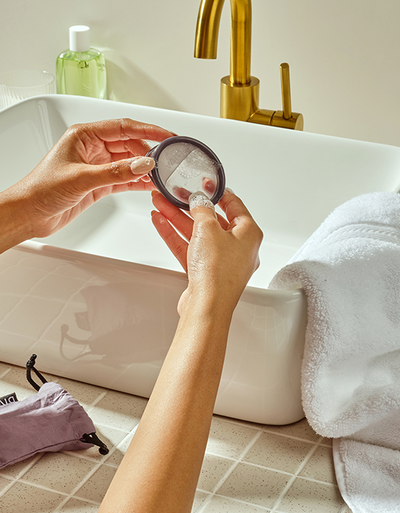

Menstrual Blood as Taboo
For centuries, menstrual blood has been positioned as a powerful, yet feared, substance. Misconceptions around its power to “sour wine, wilt crops and rust iron” date back as far as 77 A.D. And in the 1940s and 50s, the theory of menstrual toxicity suggested that human menstrual blood was lethal to young rats within 48 hours after a single injection, (Smith & Smith, 1945; Reame, N., 1983) —only to later be refuted due to discovery of contamination of samples and poor laboratory technique (Zondek, 1953; Reame, N., 1983).These ideas made headway because of centuries of fear and stigma that cast it out as “endometrial waste.” We now know that menstrual blood tests have the capacity to diagnose many period-related health problems.
Pad and tampon manufacturers claim real menstrual blood is too varied to be used in testing their products due to individual differences in blood flow. But is the saline they use a suitable substitution? And when did they recognize it was important to standardize absorbency claims?
The Tampon Task Force
It wasn’t until 1980, when 890 instances of Toxic Shock Syndrome (TSS) related to Rely tampons lead to the death of dozens of healthy young women that menstrual blood absorbency was finally investigated by the medical community.The Tampon Task Force was created to help design standards for tampon absorbency and FDA labeling recommendations. The group was comprised of manufacturers, consumer groups and women’s health advocates. The task force was divided from the very start on product classification, labeling and most importantly, absorbency.
When it came to absorbency testing, they “settled” on using a saline solution and the Syngyna test instrument (shown here).
The Syngyna test “resembles” the vaginal canal. It is a glass jar with a condom inserted inside and then surrounded by a water bath to mimic body temperature. The condom was meant to reflect the standard measurement of the vaginal canal as determined by the majority male task force. During testing, a tampon is inserted into the condom and a saline solution is dripped through the apparatus from the opposite end at a precise flow rate to test absorbency to the point of leaking.
Still to this day, menstrual product absorbency is tested using saline or water—substances which are substantially different in viscosity to menstrual blood. Tampons, which are regulated as a medical device by both the FDA and Health Canada, are approved for use while menstruating, but not actually tested with menstrual blood.
Saline vs. Menstrual Blood
Esther Rome, a founder of the Boston Women's Health Book Collective which produced the pioneering Our Bodies, Ourselves, was a key advocate for better absorbency testing. Rome called on nurse and reproductive physiologist, Nancy Reame, who had experience researching the endocrinology and characteristics of menstruation.We had a chance to talk to Nancy Reame about her research and learned that she tested tampon absorbency using heparinized blood obtained from the hospital blood bank (blood that won’t easily coagulate, like menstrual blood) using the Syngyna method. Reame noted that she found significant differences in blood and saline absorbency especially with high absorbency products. This showed that high absorbency tampons absorb more blood proportionately than saline, which suggested a labeling discrepancy.
Unfortunately, Reame’s findings were not included in formal FDA decision making as the findings were not in alignment with corporate interests. In the years that followed, absorbency guidelines made their way onto product packaging as well as TSS warnings, but the journey to these inclusions by those in the task force was not an easy one.
Reame’s findings were never released to the public or published, due to proprietary reasons. Interestingly, a 1997 patent on synthetic menses is held by a leading tampon manufacturer and includes egg whites (to mimic the mucous) and de-clotted pig blood. The patent notes that human blood could be substituted, but that huge variability in menses makes the use of menses untenable.
2023 Revelations
In August 2023, the study led by Dr Bethany Samuelson Bannow and a team of researchers at Oregon Health & Science University tested period product absorbency with whole packed RBCs (different than menstrual blood, but better than saline) using a dunk method, versus the standard Syngyna method. While vastly different from the method and heparinized blood used by Reame, this study is a small step towards better understanding menstrual product absorbency. The findings of Samuelson Bannow did indicate that several absorbent menstrual care products have less capacity than stated on packaging. The major takeaway from both Reame’s and Samuelson Bannow’s research is that saline and blood are two very different fluids, and both will behave differently when it comes to tampon absorbency.Diagnosis of heavy menstrual bleeding, and menstrual cycle related medical conditions, is dependent on insights gained from the use and absorption of disposable pads and tampons. Reame’s and Samuelson Bannow’s findings call for a re-examination of the diagnosis of menstrual health related disorders. Samuelson Bannow’s finding also suggest the best method to use to measure menstrual flow is a menstrual cup or disc, as they offer the most capacity and were the best indicator of flow volume.
What’s Next?
It’s no surprise that the history of the Tampon Task Force and all the other contributing factors leading to this 2023 study have been overlooked. In our patriarchal society, menstrual health is still too often considered “too complicated” with the variables of menstruation.Misleading absorbency metrics are not only frustrating and inconvenient, but society’s disgust with menstrual blood has cast it out as waste—when it could be used for research of menstrual bleeding disorders and development of treatment options.
Let’s stop casting out menstrual blood as simply “endometrial waste” and support initiatives like NextGen Jane and Qvin to push for the healthcare all menstruators deserve.










